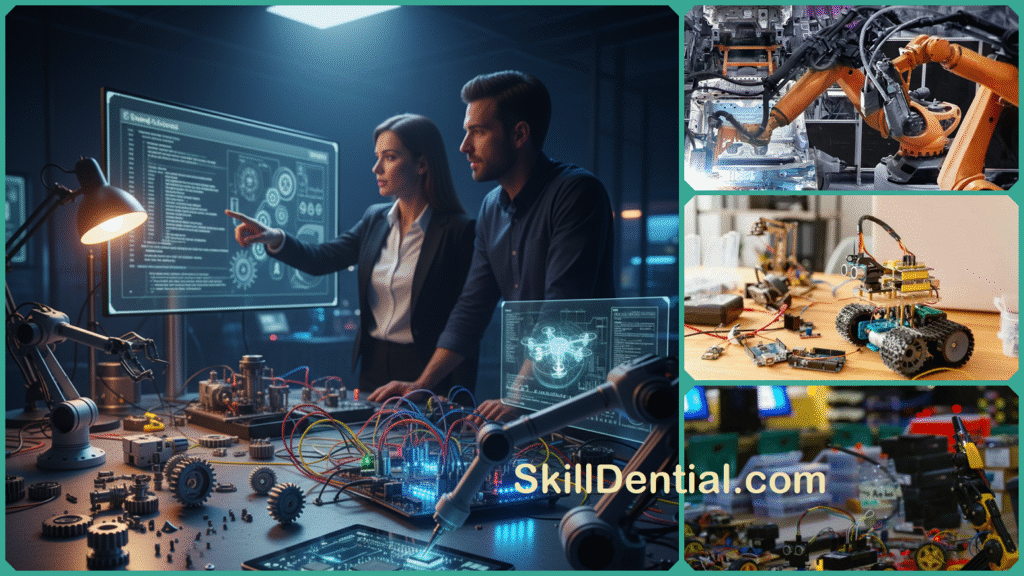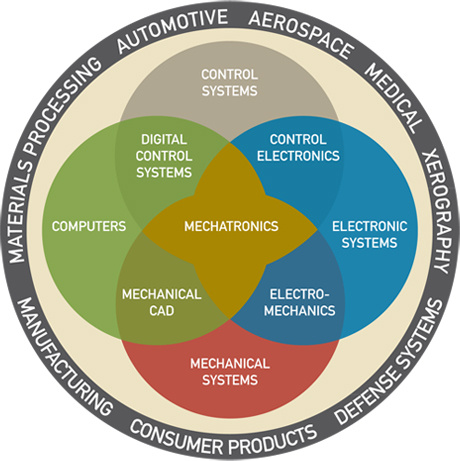Intro to Mechatronics Engineering 101: From Gears to Gadgets
Mechatronics engineering is widely recognized as a highly dynamic and interdisciplinary field that seamlessly integrates the principles of mechanics, electronics, and computing to create advanced intelligent systems. In today’s fast-paced world of technology and continuous innovation, this field plays a crucial role in developing smart solutions that enhance automation, efficiency, and functionality across various industries.
Whether it’s the advanced anti-lock braking system integrated into your car or the highly efficient robots speeding up manufacturing processes on assembly lines, mechatronics has fundamentally transformed and revolutionized the way modern devices and machines operate and perform their functions.

This blog post serves as a comprehensive and foundational guide to the field of mechatronics engineering, specifically designed for beginners who are just starting to explore this exciting area. It is ideal for a diverse audience, including.
- High school students who are considering various career paths and want to learn more about engineering options
- College students who are curious about interdisciplinary fields that combine multiple branches of engineering
- Professionals looking to expand their skill set and knowledge in emerging technologies.
- Hobbyists who have a keen interest in robotics, automation, and innovative mechanical systems.
This comprehensive guide is designed to offer a clear, detailed, and easily understandable introduction to the fundamental concepts and exciting opportunities found within the dynamic field of mechatronics engineering. It aims to help readers gain a solid foundational understanding of this multidisciplinary area and explore the various career paths and innovations it encompasses.
Understanding Mechatronics Engineering
Mechatronics engineering is an interdisciplinary engineering field that seamlessly integrates mechanical engineering, electrical engineering, and computer science to design smarter and more efficient systems and products. The term “mechatronics” was originally coined as a blend of “mechanics” and “electronics,” but it has expanded to encompass control systems, robotics, computer programming, and automation technologies.
At its foundation, mechatronics engineering involves designing mechanical mechanisms that interact with electrical controls and embedded software to perform complex tasks. Typical examples include robotic arms assembling delicate electronics or drones navigating autonomously through intricate environments, such as forests.
These systems rely on core components like sensors that collect information about the environment, actuators that produce physical actions, processors that make decisions, and feedback loops that optimize system performance in real-time.
Key components of a mechatronic system typically include several essential elements that work together seamlessly to achieve precise control and automation. These usually consist of:
- Mechanical components such as gears, frames, and linkages play a crucial role in the design and functionality of machinery and mechanical systems. Gears are essential for transmitting power and motion between different parts, enabling precise control of speed and torque. Frames provide the structural support necessary to hold various components together, ensuring stability and alignment under operational stresses. Linkages serve as the connecting elements that transfer motion and force between different parts, allowing complex movements and mechanical advantages to be achieved efficiently within a system.
- Sensors are essential devices designed to detect and measure various parameters such as position, speed, and temperature. These sensors play a crucial role in gathering accurate data, allowing systems to monitor and respond to changes in their environment effectively. By continuously detecting parameters like position, speed, and temperature, sensors enable precise control and automation in numerous applications across different industries.
- Actuators, which include devices such as motors and solenoids, are essential components that generate movement or perform specific mechanical actions in various systems and machines. These actuators convert electrical energy into physical motion, enabling the operation of different mechanisms and processes.
- Controllers or microcontrollers are essential components used to process sensor data and manage the operation of actuators. These devices serve as the brains of many electronic systems, interpreting input signals from various sensors and then executing control commands to actuators accordingly. By handling sensor data efficiently, controllers or microcontrollers enable precise and timely responses in automated processes, making them crucial for the smooth functioning of complex systems.
- Software and algorithms are essential components designed to coordinate and manage the overall behavior of the entire system, ensuring it functions seamlessly and efficiently. These elements work together to control various processes, optimize performance, and handle complex tasks, ultimately enabling the system to operate in a cohesive and synchronized manner.
This integration makes mechatronic systems more intelligent, efficient, and adaptable than traditional mechanical or electrical systems alone. By combining these multiple disciplines, engineers create innovative solutions that are widely applied in automotive safety features, automated manufacturing, consumer electronics, and robotics, among other areas.
In Summary
Mechatronics engineering focuses on designing and developing intelligent systems in which mechanical parts, electronic components, and advanced computer controls seamlessly work together in perfect harmony to perform complex and sophisticated tasks.
This field effectively bridges the significant gap between traditional mechanical gears and the latest modern high-tech gadgets, seamlessly integrating multiple disciplines and areas of expertise to develop and create innovative solutions that address complex challenges.
The Significance of Mechatronics
Mechatronics engineering is highly significant for beginners because it serves as a central pillar for numerous vital technologies that are shaping the future across various industries. It is a gateway to exciting careers in cutting-edge fields such as
- Robotics
- Automation
- Automotive systems
- Medical devices
- Consumer electronics
These sectors are experiencing rapid growth and innovation. For students and professionals, gaining a foundational understanding of mechatronics equips them to excel at the intersection of hardware and software, driving innovation and solving complex engineering problems in real-world applications.
By mastering the field of mechatronics, individuals equip themselves with the essential skills and knowledge to become highly valuable contributors in the innovative design and development of intelligent machines and advanced automated systems.
These systems play a crucial role in enhancing safety standards, boosting operational efficiency, and significantly improving the overall quality of life for people across various industries and everyday environments.
Moreover, mechatronics is crucial for developing sustainable and smart solutions such as renewable energy systems and autonomous vehicles. This makes it a forward-looking discipline with wide-reaching implications for the global economy and technological advancement.
Fundamental Key Concepts and Essential Theories in the Field of Mechatronics
- Interdisciplinarity and Integration: Mechatronics is inherently multidisciplinary, involving the combination of mechanical systems, electronic circuits, and computer algorithms into integrated solutions. This fusion ensures that systems are not only functional but are optimized for high performance, reliability, and cost-effectiveness. Engineers design solutions where these domains work seamlessly together rather than in isolation, enabling smarter and more adaptable machines.
- Sensors and Actuators: Sensors are devices that detect and measure physical parameters like temperature, pressure, position, or speed from the environment. They serve as the system’s input interface by gathering real-time data. Actuators, conversely, convert electrical signals into physical actions, such as rotating a motor or moving a hydraulic piston. Together, sensors and actuators form the crucial feedback loop that underpins the control and responsiveness of mechatronic systems.
- Control Systems and Algorithms: Control engineering is essential for ensuring systems behave as intended despite external disturbances or variable conditions. This is often achieved through feedback control loops, executed by microcontrollers or embedded systems. Algorithms process sensor inputs and determine the precise commands sent to actuators in real time. A well-known practical example is the anti-lock braking system (ABS) in modern cars, which continuously adjusts brake pressure to prevent wheel lockup.
- Embedded Systems and Programming: Embedded microprocessors or microcontrollers are the brains governing mechatronic systems. These compact computing units run specialized software written in languages such as C, C++, or Python to control actuators, manage sensors, and execute system logic autonomously or semi-autonomously. Programming embedded systems is vital for managing complex processes, ensuring timely responses, and maintaining system stability and safety.
- Mechanical Design and Simulation: Mechanical components of mechatronic systems—including gears, frames, levers, and linkages—are carefully designed using CAD (Computer-Aided Design) software. Engineers simulate mechanical performance and interactions with electronic components virtually to identify potential issues before physical manufacturing. This practice leads to enhanced design efficiency and reliability when the final product is built.
Together, these interconnected concepts form the essential core framework necessary to build highly intelligent, adaptive, and efficient systems. In these systems, mechanical hardware, advanced electronics, and sophisticated computational intelligence work seamlessly in collaboration.
This integrated approach aims to significantly enhance human experiences across diverse applications while simultaneously boosting industrial productivity and operational effectiveness to unprecedented levels.
Career Opportunities and Industry Impact
Mechatronics engineering offers a wide range of diverse career opportunities across various industries, all of which have strong potential for growth and advancement. Professionals in this field can pursue roles such as embedded systems development, where they design and implement software and hardware integration. They can also work in robotic systems design, creating advanced robots for manufacturing and other applications.

Additionally, opportunities exist in automotive electronics engineering, focusing on the development of electronic components and systems for vehicles. Mechatronics engineers are also involved in renewable energy integration, helping to incorporate sustainable energy solutions into existing systems.
Other key roles include automation and process control, optimizing industrial operations through advanced technologies, and providing guidance and control for unmanned vehicles, including drones and autonomous systems.
Industries that are actively seeking and hiring skilled mechatronics professionals include a wide range of sectors, such as
- Automotive manufacturing, particularly in the development of autonomous vehicles
- Aerospace Engineering
- Healthcare technology focusing on robotic surgical devices
- Industrial automation systems
- Consumer electronics
- Advanced energy systems
Graduates with expertise in mechatronics frequently find excellent employment opportunities at some of the world’s leading multinational corporations, including well-known names like Jaguar Land Rover, Rolls-Royce, Siemens, ABB, BP, and BAE Systems, where their skills are highly valued and in demand.
Salaries for mechatronics-related roles tend to be highly competitive, reflecting both the strong demand for professionals in this field and the specialized skills and knowledge required to excel. Positions such as
They are generally well-compensated, offering not only attractive financial rewards but also fulfilling and engaging career opportunities. These roles often come with benefits that recognize the expertise and technical proficiency needed, making them both financially and professionally rewarding choices for individuals pursuing careers in mechatronics.
For beginners, learning mechatronics offers an essential launchpad that enables them to actively participate in the development and advancement of these transformative technologies. By gaining knowledge and skills in mechatronics, individuals can contribute meaningfully to innovations that significantly enhance safety, improve sustainability, and drive automation on a global scale across various industries.
In Summary
Mechatronics engineering is a critical and rapidly evolving field, blending multiple engineering disciplines to create intelligent systems. Understanding its significance, key concepts, and career prospects empowers beginners to make informed decisions about entering this exciting domain.
By mastering sensors, actuators, control systems, embedded programming, and mechanical design, learners can build and innovate smart technologies impacting industries worldwide. The interdisciplinary nature and real-world applications make mechatronics a highly appealing and future-ready field to explore.
Current Trends and Developments in Mechatronics Engineering
In the dynamic field of mechatronics engineering, the discipline is continuously evolving by incorporating cutting-edge and innovative technologies that are actively shaping and redefining the future landscape of automation and intelligent smart systems.
Prominent emerging trends such as the seamless integration of artificial intelligence, machine learning algorithms, and highly advanced robotics are significantly pushing the boundaries of what was previously thought possible, resulting in the creation of increasingly intelligent, fully autonomous, and highly efficient machines and devices.
- Advanced Robotics and Automation: Mechatronics is significantly advancing robotics beyond traditional factory settings, expanding into healthcare, agriculture, and service industries. Robots today are equipped with sophisticated sensors and artificial intelligence (AI) algorithms that allow them to perform complex tasks such as assisting in surgeries, monitoring crop health, and even performing household chores. These intelligent robots enhance precision, efficiency, and accessibility across diverse applications, illustrating how mechatronics integrates multiple technologies to create next-generation automated systems.
- Autonomous Vehicles: The development of autonomous vehicles, including self-driving cars and drones, is a prominent trend powered by mechatronics. These vehicles rely on a combination of sensors, control systems, and decision-making algorithms to safely navigate complex and dynamic environments without human intervention. Mechatronics engineers develop the embedded systems and integrated controls that enable real-time processing of environmental data and autonomous decision-making critical for safe and efficient operation.
- Flexible and Adaptive Robots: Mechatronics is enabling the design of flexible and adaptive robots capable of functioning in unpredictable or hazardous environments. For example, robots used in search and rescue missions can adjust their behaviors and movements dynamically to respond to changing conditions. In industrial settings, robots are becoming more versatile, with the ability to quickly switch between different tasks, boosting productivity and workplace safety.
- Smart Consumer Products: Mechatronics principles are embedded in many everyday consumer products, enhancing their functionality. Examples include autofocus cameras, smart home automation devices, and smartphones that integrate mechanical components, sensors, and embedded software for a superior user experience. These smart gadgets demonstrate how mechatronics combines mechanics, electronics, and computing to create intuitive, effective consumer technology.
- Medical Mechatronics: In medical technology, mechatronics is revolutionizing patient care through sophisticated devices like robotic surgery tools and automated diagnostic machines. These devices require high precision, reliability, and automation, made possible through integrated mechanical design, sensors, control systems, and computer programming. Such innovations improve surgical outcomes, accelerate diagnostics, and enhance overall healthcare delivery.
Emerging Innovations and Breakthrough Developments in Technology
- AI and Machine Learning Integration: Modern mechatronic systems are increasingly incorporating advanced AI technologies and machine learning algorithms to significantly improve predictive maintenance, adaptive control, and autonomous decision-making capabilities. This integration not only enhances the overall intelligence of these systems but also greatly boosts their operational efficiency and reliability in a wide range of applications.
- Internet of Things (IoT): IoT-enabled mechatronic systems facilitate highly interconnected and integrated operations across various sectors. For example, smart grids utilize IoT technology to intelligently optimize energy consumption, enhancing efficiency and reducing waste. Similarly, Industrial IoT (IIoT) connects manufacturing equipment and machinery, allowing for continuous real-time monitoring, predictive maintenance, and improved operational performance in industrial environments.
- Human-Robot Interaction (HRI): Significant developments in the field of collaborative robots, commonly known as cobots, as well as advancements in wearable robotics and social robots, have greatly improved how humans and machines can work together more effectively and seamlessly. These innovations leverage cutting-edge technologies such as augmented reality and intuitive voice control systems to create more natural and efficient collaboration between people and robotic devices. As a result, the integration of these technologies enhances teamwork, productivity, and overall user experience in various environments.
- Materials and Manufacturing: Significant advances in smart materials, nano-engineering techniques, 3D printing technology, and additive manufacturing processes are greatly optimizing the overall design, adaptability, and production speed of a wide range of mechatronic devices. These innovations are enabling engineers to create more efficient, flexible, and customized components faster than ever before, pushing the boundaries of what is possible in mechatronics development and manufacturing.
In Summary
Mechatronics is continuously evolving at a rapid pace, driven by groundbreaking advancements in artificial intelligence, robotics, materials science, and connectivity technologies. These innovations are collectively shaping a future in which intelligent systems become increasingly integral and indispensable not only to various industries but also to everyday life.
Staying informed and keeping abreast of these emerging trends and technological developments is absolutely essential for professionals who aspire to lead and excel in this highly dynamic and ever-changing field.
Real-World Examples of Mechatronics Engineering
Mechatronics engineering is far from just a theoretical concept; its principles are at work all around us, powering the systems and devices we rely on daily. By seamlessly blending different engineering disciplines, mechatronics has made our world smarter, more efficient, and more automated.
Let’s take an in-depth look at some of the most common, popular, and innovative examples of this exciting field in action today. These examples showcase a wide range of applications and demonstrate the remarkable advancements and creative approaches currently shaping the industry.
- Anti-lock Braking Systems (ABS) in Automobiles: ABS serves as a prime and widely recognized example of mechatronics technology in practical use. This system employs multiple sensors that continuously monitor the rotational speed of each wheel. The data collected by these sensors is then processed by sophisticated control algorithms designed to analyze the situation in real time. Based on this analysis, electronic actuators precisely adjust and modulate the brake pressure applied to each wheel. This dynamic modulation effectively prevents the wheels from locking up during sudden or hard braking maneuvers. As a result, ABS significantly enhances overall vehicle safety by maintaining optimal traction between the tires and the road surface, while also ensuring that the driver retains full steering control during emergency stops or on slippery surfaces.
- Industrial Robotics: Mechatronics plays a transformative role in industrial robotics, especially within manufacturing sectors such as automotive, plastics, rubber, and metal industries. Robots designed by mechatronics engineers perform tasks including spot welding, arc welding, assembly, materials handling, and packaging with high accuracy and efficiency. These robots reduce human error, operate efficiently in hazardous environments, and enable continuous production with minimal downtime. Technologies like sensor feedback, AI, and machine vision enable robots to handle complex assembly tasks and adapt to different production requirements, making manufacturing more precise and productive.
- UAVs and Drones: Drones, or unmanned aerial vehicles (UAVs), rely on mechatronic systems for stabilized flight, sensor data processing, and autonomous navigation. Using integrated sensors such as GPS, accelerometers, and cameras, drones can perform diverse applications ranging from aerial photography to agricultural monitoring and package delivery. Their autonomous capabilities stem from embedded control systems that continuously interpret environmental data and execute navigational algorithms to maintain flight stability and avoid obstacles.
- Autonomous Warehouse Systems: Automated guided vehicles (AGVs) in warehouses exemplify mechatronics in logistics. AGVs use sensors, embedded controls, and navigation algorithms to move goods efficiently, reducing the need for manual labor in repetitive and labor-intensive tasks. These vehicles optimize warehouse operations by improving speed, accuracy, and safety in material handling, inventory management, and order fulfillment. Mechatronics integration allows them to operate collaboratively with human workers and other machines, making warehouses smarter and more responsive to changing demands.
Summary of the Real-World Examples of Mechatronics Engineering
| Example | Application Area | Mechatronics Components | Impact |
|---|---|---|---|
| Anti-lock Braking (ABS) | Automotive Safety | Sensors, control algorithms, actuators | Improves vehicle safety and control |
| Industrial Robotics | Manufacturing | Sensors, actuators, AI, robot arms | Enhances precision, productivity, and safety |
| UAVs and Drones | Aerial Systems | Sensors, embedded controls, navigation software | Enables autonomous navigation and data capture |
| Autonomous Warehouse AGVs | Logistics and Warehousing | Sensors, embedded systems, navigation algorithms | Optimizes material handling and reduces labor |
These examples clearly illustrate how mechatronics engineering successfully integrates multiple interdisciplinary fields to effectively solve complex real-world problems. By combining elements from mechanical engineering, electronics, computer science, and control engineering, this approach makes everyday technologies significantly smarter, much safer, and considerably more efficient in their operation and functionality.
Inspiring Further Learning in Mechatronics Engineering
For those intrigued by mechatronics engineering, many academic programs, certifications, and online courses provide comprehensive and in-depth study opportunities. Many universities globally offer Bachelor of Engineering (B.Eng) or Bachelor of Science (B.S.) degree programs in mechatronics, typically lasting four to five years.
These programs integrate coursework in mechanical design, electronics, embedded systems, control engineering, robotics, automation, sensors, and computer programming. For example, institutions like the
- University of Nigeria, Nsukka
- Saint Mary’s University of Minnesota
- Nile University of Nigeria
- The Bells University
The institutions provide robust mechatronics curricula combined with practical and industrial placements to prepare students for real-world challenges. Aside from formal degrees, many online platforms such as Coursera, edX, and Udemy offer specialized certifications and project-based courses.
These online courses often include hands-on projects like building simple robots, developing automation kits, or programming microcontrollers that make theoretical concepts tangible and practicable. Experiential learning through such projects is invaluable to understanding system integration, control systems, and embedded programming, all vital to mechatronics expertise.
Because mechatronics spans various engineering disciplines, deepening proficiency across mechanical design (CAD, CAM), electrical circuits, embedded programming (C, C++, Python), and control theory will build strong technical foundations. Many programs also emphasize soft skills like problem-solving, communication, and project management, which are essential for professional success.
For professionals aiming to upskill, targeted workshops and certificate courses in specific tools or software (such as MATLAB, LabVIEW, ROS, or PLC programming) are valuable. Engaging in open-source projects, robotics clubs, hackathons, and maker communities further fosters practical skills and networking in the mechatronics field.
In Summary
Aspiring mechatronics engineers are encouraged to leverage a diverse combination of academic degrees, professional certifications, and practical hands-on projects to develop a well-rounded and interdisciplinary expertise.
By exploring this dynamic and rapidly evolving field through carefully structured learning paths and engaging in active experimentation, individuals can unlock a wide range of innovative career opportunities. This approach also provides the valuable chance to design and create impactful smart systems that address real-world challenges and drive technological advancements.
FAQs
What skills do I need to start learning mechatronics engineering?
Essential skills include a solid foundation in mechanical engineering principles, basic electronics, programming (especially C, C++, and Python), and mathematics such as calculus and linear algebra. Analytical thinking, problem-solving abilities, and an interest in robotics and automation are also important motivators for learning deeper concepts. Familiarity with CAD software, microcontrollers, and sensors enhances practical competence.
Is mechatronics only for engineers?
Mechatronics is accessible to hobbyists and enthusiasts as well. DIY robotics kits, maker projects, and online tutorials make it possible for non-engineers to engage with and enjoy mechatronics concepts. It’s a hands-on field that encourages experimentation and creativity beyond formal engineering education.
How is mechatronics different from robotics?
Mechatronics is broader, focusing on integrating mechanical, electronic, and computing systems into intelligent products. Robotics is a specialized branch within mechatronics focused specifically on designing and building robots, but mechatronics also covers automated manufacturing systems, smart consumer gadgets, and more.
What industries employ mechatronics engineers?
Mechatronics engineers work in diverse sectors, including automotive, aerospace, manufacturing, healthcare, consumer electronics, energy, automation, and robotics industries. Their skills are relevant wherever smart electromechanical systems are designed, built, or maintained.
Can mechatronics help with future job security?
As industries increasingly adopt automation, AI-driven machinery, and smart systems, the demand for mechatronics professionals continues to grow globally. The interdisciplinary expertise of mechatronics engineers positions them well for emerging roles in innovative and expanding fields.
In Conclusion
Mechatronics engineering is a fascinating and forward-looking discipline that bridges the world of gears and gadgets with intelligence and control. By seamlessly integrating mechanical engineering, electronics, and computing, it creates smarter machines that enhance both everyday life and industrial processes.
This interdisciplinary arena opens up numerous career paths, from robotics and automotive systems to healthcare devices and consumer electronics, offering professionals the chance to innovate and solve complex challenges.
For beginners eager to explore mechatronics, the journey promises intellectual rewards and practical impacts. Diving deeper into this field can lead to transformative projects, advanced technical knowledge, and an influential role in shaping the evolving technological landscape of tomorrow.
Whether through academic study, hands-on experimentation, or professional development, embracing mechatronics today lays the groundwork for a future enriched with intelligent, automated, and adaptive systems that improve our world.
Discover more from SkillDential
Subscribe to get the latest posts sent to your email.




